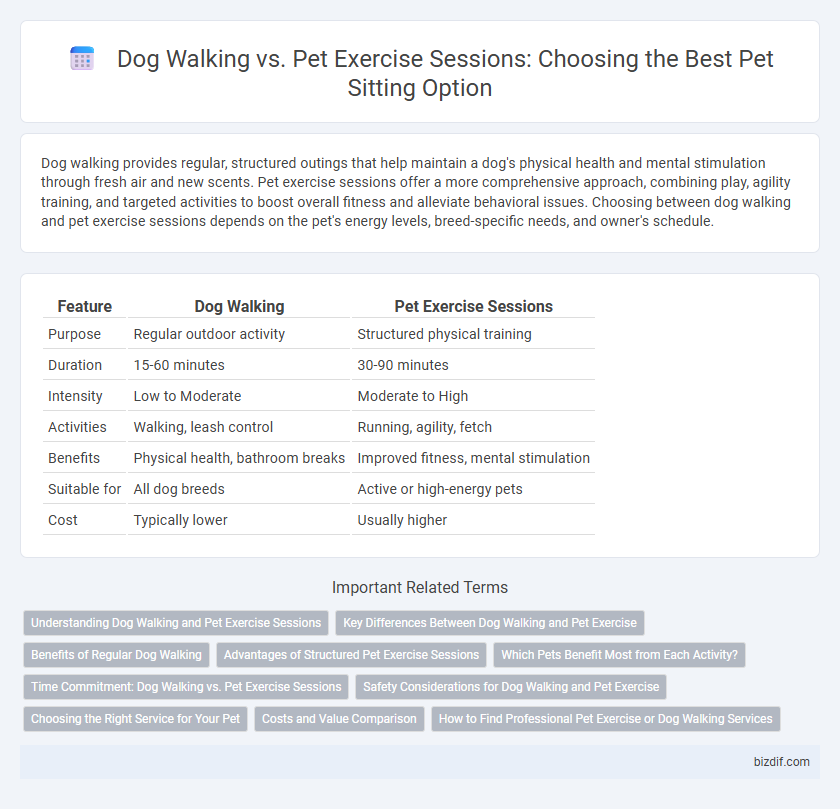Dog walking provides regular, structured outings that help maintain a dog's physical health and mental stimulation through fresh air and new scents. Pet exercise sessions offer a more comprehensive approach, combining play, agility training, and targeted activities to boost overall fitness and alleviate behavioral issues. Choosing between dog walking and pet exercise sessions depends on the pet's energy levels, breed-specific needs, and owner's schedule.
Table of Comparison
| Feature | Dog Walking | Pet Exercise Sessions |
|---|---|---|
| Purpose | Regular outdoor activity | Structured physical training |
| Duration | 15-60 minutes | 30-90 minutes |
| Intensity | Low to Moderate | Moderate to High |
| Activities | Walking, leash control | Running, agility, fetch |
| Benefits | Physical health, bathroom breaks | Improved fitness, mental stimulation |
| Suitable for | All dog breeds | Active or high-energy pets |
| Cost | Typically lower | Usually higher |
Understanding Dog Walking and Pet Exercise Sessions
Dog walking primarily involves guided outdoor strolls tailored to a dog's pace, promoting physical activity and mental stimulation through exposure to varied environments. Pet exercise sessions extend beyond simple walks to include structured activities like agility training, fetch, or treadmill workouts designed to meet specific fitness goals and support overall health. Understanding the differences helps pet owners choose appropriate care based on their dog's breed, age, energy levels, and behavioral needs.
Key Differences Between Dog Walking and Pet Exercise
Dog walking primarily involves taking dogs on leash for short to moderate outdoor strolls focused on physical activity and bathroom breaks, while pet exercise sessions encompass a broader range of activities designed to stimulate both physical and mental health, such as agility training, fetch, and obedience drills. Dog walking is generally a routine, time-limited activity, whereas pet exercise sessions are often structured, varied, and tailored to the individual pet's fitness needs and behavioral goals. The intensity and purpose distinguish dog walking as mainly cardiovascular exercise and pet exercise sessions as comprehensive fitness and enrichment routines.
Benefits of Regular Dog Walking
Regular dog walking supports physical health by promoting cardiovascular fitness, muscle strength, and weight control, reducing the risk of obesity and related diseases. Consistent walks stimulate mental health through exposure to new environments and social interactions, alleviating anxiety and behavioral issues. Structured exercise sessions may vary in intensity, but daily walks ensure steady stimulation, fostering a balanced lifestyle for dogs.
Advantages of Structured Pet Exercise Sessions
Structured pet exercise sessions offer tailored physical activities designed to meet the specific needs of each dog, promoting better overall health and behavior. These sessions typically include a combination of strength, endurance, and mental stimulation exercises, which help reduce anxiety and prevent obesity more effectively than simple dog walking. Professional supervision during structured exercise ensures safety and optimizes the benefits of physical activity through consistent routines and goal-oriented training.
Which Pets Benefit Most from Each Activity?
Dogs, especially high-energy breeds like Border Collies and Labradors, benefit most from regular dog walking sessions that provide consistent physical activity and socialization. Pets such as rabbits, ferrets, and some cats gain more from tailored pet exercise sessions that accommodate their specific mobility needs and mental stimulation requirements. Choosing between dog walking and pet exercise sessions depends on the species, energy level, and individual health of the pet to ensure optimal physical and emotional well-being.
Time Commitment: Dog Walking vs. Pet Exercise Sessions
Dog walking typically involves short, structured outings lasting 15 to 30 minutes, suitable for daily or multiple times per day schedules. Pet exercise sessions often require longer, more flexible time commitments ranging from 30 minutes to an hour, allowing for diverse activities like fetch, agility drills, or playtime. Choosing between the two depends on the pet's energy levels and the owner's availability to maintain consistent physical activity for their dog's health and well-being.
Safety Considerations for Dog Walking and Pet Exercise
Dog walking requires careful attention to leash control and traffic awareness to prevent accidents and ensure the dog's safety in urban environments. Pet exercise sessions often take place in enclosed spaces, reducing risks but necessitating supervision to avoid overexertion or injury during play. Both activities demand knowledge of the pet's health conditions and proper hydration to maintain safety and well-being.
Choosing the Right Service for Your Pet
Dog walking offers structured outdoor activity tailored to your pet's size and energy level, ideal for building stamina and socialization. Pet exercise sessions provide a more comprehensive approach, combining strength, agility, and mental stimulation through varied indoor and outdoor activities. Selecting the right service depends on your dog's specific needs, age, breed, and health condition to ensure balanced physical and mental wellness.
Costs and Value Comparison
Dog walking services typically cost between $15 to $30 per 30-minute walk, offering routine exercise and bathroom breaks for pets. Pet exercise sessions, often priced from $40 to $75 per hour, provide more comprehensive activities like playtime, training, and socialization, enhancing a pet's physical and mental well-being. Choosing between the two depends on budget and the pet's specific needs for activity intensity and engagement.
How to Find Professional Pet Exercise or Dog Walking Services
Locating professional pet exercise or dog walking services requires checking credentials such as pet first aid certification and verified client reviews. Search platforms like Rover or Wag provide detailed profiles and insurance-backed guarantees for trusted caregivers. Ensuring the provider offers customized exercise tailored to breed, age, and health needs optimizes pet wellness and safety.
Dog walking vs Pet exercise sessions Infographic

 bizdif.com
bizdif.com